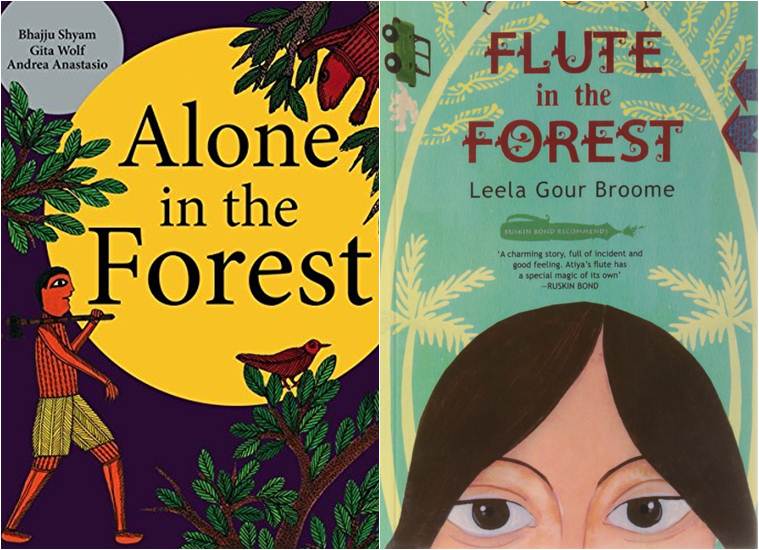 Book cover of Ranjit Lal’s How Wondrous is That: Nature’s Bizarre… (L) and Madhuri Ramesh, Manish Chandi and Matthew Frame’s Walking is a Way of Knowing in a Kadar Forest.
Book cover of Ranjit Lal’s How Wondrous is That: Nature’s Bizarre… (L) and Madhuri Ramesh, Manish Chandi and Matthew Frame’s Walking is a Way of Knowing in a Kadar Forest.
Since 2012, March 21 has been designated by the United Nations for a global celebration of our fast-depleting forest lands. While forests have been a prominent feature of children’s literature in the West — think Hansel and Gretel and other fairy tales from Brothers Grimm to JK Rowling’s Harry Potter series — Indian writing in English for children have now expanded its repertoire to accommodate a wider understanding of forests and the wildlife it hosts. This week, we look at a mix of fiction and non-fiction works anchored in nature.
* As ill-conceived forest corridors and river linkage projects threaten to exacerbate man-nature conflict, Madhuri Ramesh, Manish Chandi and Matthew Frame’s Walking is a Way of Knowing in a Kadar Forest (2017, Tara Books, appropriate for: 8+) is a look at the lives of those who live in mostly symbiotic harmony with their natural surroundings. The Kadars are an indigenous forest tribe living in the Annamalai Hills of southern India, whose intuitive knowledge of jungles is born of long years of association with it. Every tree, every stream and meandering forest path (or its lack) is a marker on their invisible map of the land, intended to keep them attuned to the changing landscape of the forest and safe from attacks from wild animals. For the urbanite authors, walking with them through the forests was a lesson in slow discovery: “For they taught us that…Walking involved not only movement, but attentive observation and a sense of timing; it also required us to be acutely aware of colour, light, sound and silence in the forest.” This is a book to be savoured one page at a time, thrilling in the joy of vicariously experiencing what it means to be one with nature.
* If you won’t go to the forest, there’s no reason why it shouldn’t come to you. Ranjit Lal has for long delighted his young (and old) readers with the fruits of his patient surveillance of the natural world around him, especially of the winged wonders that he has keenly observed for decades. In How Wondrous is That: Nature’s Bizarre… (2017, TERI, appropriate for: 7+), he takes readers on a tour of the avian world right in the heart of the urban jungle, aka the city (give or take a pelican or two). The weaver bird and its marvel of a nest, the plucky babbler, whose ruffian airs hide a soft heart, the incredible acrobatic skills of the rosy starlings all come alive in this short but delightful book.
 Book cover of Leela Gour Broome’s In Flute in the Forest (R) and Gita Wolf, Andrea Anastasio and Bhajju Shyam’s Alone in the Forest.
Book cover of Leela Gour Broome’s In Flute in the Forest (R) and Gita Wolf, Andrea Anastasio and Bhajju Shyam’s Alone in the Forest.
* With a large part of her childhood spent on a tea estate near Kodaikanal in Tamil Nadu, it is little wonder that in writer Leela Gour Broome’s books, the great outdoors play a crucial role. In Flute in the Forest (2010, Penguin, appropriate for 10+), 13-year-old Athiya lives with her father, a forest ranger, on the edge of a forest in south India. Afflicted by polio in her childhood, Athiya is a sensitive teenager who finds comfort in the unlikely secrets the forest yields when she goes on solo excursions to forget her classmates’ taunts about her disability. On one such visit, Athiya is mesmerised by the sound of a flute and is determined to learn how to play the instrument, even though her protective father is not too keen on the idea. It’s a simple coming-of-age story, but throw in a gruff anthropologist, his Kurumba daughter, Mishora, a rogue elephant, and you have a novel that weaves in the healing powers of nature, music and meaningful relationships to a satisfying end.
* Can a forest teach one how to conquer one’s fear of the unknown? On a day when his mother is unwell, Musa, a young tribal boy, volunteers to help out by collecting wood from the forest. But as he ventures into it, the jungle seems to change into a sinister shape-shifting entity, very different from how he has known it during his forays with his mother. Musa’s fears grow when he is startled by a loud noise. Hiding in the hollow of a tree, he imagines a herd of boars on rampage and other great dangers befalling him. In Alone in the Forest (2013, Tara Books, appropriate for 6+), Gita Wolf and Andrea Anastasio’s retelling of a tribal folk tale is brought to vivid life by Gond artist Bhajju Shyam. Shyam uses solid blocks of colours — reds and blacks — and a web of patterns to convey Musa’s growing unease in it. In one particularly evocative sequence, the reader can only see Musa’s terrified eyes peeping out from a dense maze of branches. The spell breaks only when a friendly squirrel hops over and Shyam shows the shift with a change in his colour palette — instead of the brooding, dark tones, he now uses mellower greens, blues and yellows. Musa reaches home safely, but not before he learns a lesson: our worst fears often exist only in our minds.